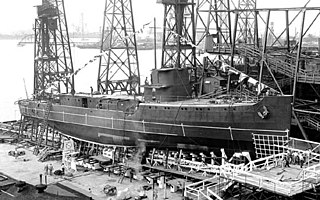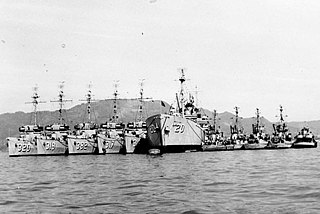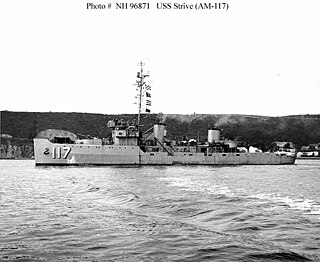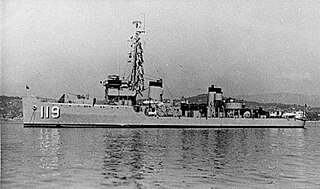USS Chickadee (AM-59) was an Auk-class minesweeper of the United States Navy, named after the Chickadee, a family of small passerine birds which appear in North America and Africa.
USS Pigeon (AM-374) was an Auk-class minesweeper acquired by the United States Navy for the dangerous task of removing mines from minefields laid in the water to prevent ships from passing.

USS Auk (AM-57) was an Auk-class minesweeper acquired by the United States Navy for the dangerous task of removing mines from minefields laid in the water to prevent ships from passing.

USS Seer (AM-112/MSF-112/MMC-5) was an Auk-class minesweeper of the United States Navy that served during World War II and the Korean War, and was sold to Norway in 1962.
USS Swift (AM-122) was an Auk-class minesweeper acquired by the United States Navy for the dangerous task of removing mines from minefields laid in the water to prevent ships from passing.

USS Toucan (AM-387) was an Auk-class minesweeper acquired by the United States Navy for the dangerous task of removing mines from minefields laid in the water to prevent ships from passing. She was the only U.S. Navy ship named for the toucan, a brightly colored and easily tamed bird of the American tropics, characterized by its large but thin beak.

USS Shoveler (AM-382) was an Auk-class minesweeper acquired by the U.S. Navy for the dangerous task of removing mines from minefields laid in the water to prevent ships from passing.

USS Towhee (AM-388) was an Auk-class minesweeper acquired by the United States Navy for the dangerous task of removing mines from minefields laid in the water to prevent ships from passing.

USS Tercel (AM-386) was an Auk-class minesweeper acquired by the United States Navy for the dangerous task of removing mines from minefields laid in the water to prevent ships from passing.

USS Sprig (AM-384) was an Auk-class minesweeper acquired by the United States Navy for the dangerous task of removing mines from minefields laid in the water to prevent ships from passing.

USS Staff (AM-114) was an Auk-class minesweeper acquired by the United States Navy for the dangerous task of removing mines from minefields laid in the water to prevent ships from passing.

USS Strive (AM-117) was an Auk-class minesweeper acquired by the United States Navy for the dangerous task of removing mines from minefields laid in the water to prevent ships from passing.

USS Steady (AM-118) was an Auk-class minesweeper acquired by the United States Navy for the dangerous task of removing mines from minefields laid in the water to prevent ships from passing.

USS Sustain (AM-119) was an Auk-class minesweeper acquired by the United States Navy for the dangerous task of removing mines from minefields laid in the water to prevent ships from passing.

USS Threat (AM-124) was an Auk-class minesweeper acquired by the United States Navy for the dangerous task of removing mines from minefields laid in the water to prevent ships from passing.
USS Token (AM-126) was an Auk-class minesweeper acquired by the United States Navy for the dangerous task of removing mines from minefields laid in the water to prevent ships from passing.
USS Tumult (AM-127) was an Auk-class minesweeper acquired by the United States Navy for the dangerous task of removing mines from minefields laid in the water to prevent ships from passing.
USS Strategy (AM-308) was a steel-hulled Admirable-class minesweeper built for the U.S. Navy during World War II. She had a courageous and adventurous life in clearing minefields in areas controlled by Japanese forces. She survived attacks by Japanese gunfire and planes, and won four battle stars for her service under battle conditions.
USS Staunch (AM-307) was a steel-hulled Admirable-class minesweeper built for the U.S. Navy during World War II. Her crew was quickly trained in the art of minesweeping and then sent to the Pacific Ocean to clear dangerous mine fields so that Allied troops could land on Japanese-held beaches. Because of her courageous work under fire, she was awarded four battle stars.
USS Ransom (AM-283) was an Admirable-class minesweeper built for the United States Navy during World War II. She was awarded three battle stars for service in the Pacific during World War II. She was decommissioned in March 1947 and placed in reserve. Although she did not see service in the war zone, Ransom was recommissioned in March 1951 during the Korean War and remained in commission until September 1953, when she was placed in reserve again. While she remained in reserve, Ransom was reclassified as MSF-283 in February 1955 but never reactivated. In 1962 she was sold to the Mexican Navy and renamed ARM DM-12. In 1994 she was renamed ARM Teniente Juan de la Barrera (C55). She was stricken in 2000, but her ultimate fate is not reported in secondary sources.











